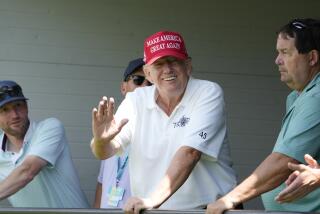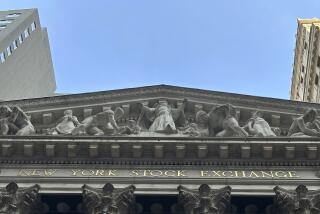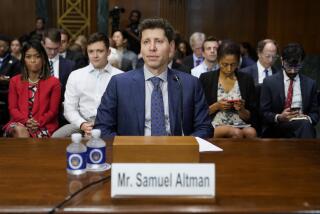Wall St. Assails Stock, Leaders at LeapFrog
- Share via
LeapFrog Enterprises Inc. is learning a tough lesson in the ways of Wall Street.
Management of the leading educational toy maker came under fire Thursday after disclosing again that its business would trail expectations -- an announcement that sparked a 25% plunge in its stock.
“A substantial part of the sell-off is a loss of investor confidence” in the creator of LeapPad laptop games and other interactive toys, said Natalie Walrond, an analyst with Pacific Growth Equities Inc.
The stock, which began tumbling in after-hours trading Wednesday after LeapFrog made its disclosure, ended Thursday’s session at $19.60, down $6.40 on the New York Stock Exchange.
Only five months ago, LeapFrog shares were at $47.30. Since then, the stock has fallen 59% as the company issued a string of disappointing news, wiping out $1.7 billion of the toy maker’s overall market value.
Walrond said in a report to clients that LeapFrog’s announcement was “yet another example of management’s inability to accurately forecast its own business and manage [Wall] Street expectations.”
LeapFrog, based in Emeryville, Calif., also is the latest example of the turmoil in the U.S. toy industry, where several trends are causing problems for both manufacturers and specialty retailers.
In recent months, FAO Inc., owner of the FAO Schwarz and Zany Brainy toy stores, and KB Toys Inc. have filed for bankruptcy protection. Toys R Us Inc. also is struggling.
But investors and analysts were especially stunned by LeapFrog’s gloomy forecast because it came only a few weeks after the company had provided its most recent guidance about its 2004 outlook. And that raised questions about the company’s leadership.
“We believe that management credibility is very low,” analyst Jeetil Patel of Deutsche Bank said in a note to clients. He downgraded LeapFrog to “sell.”
LeapFrog spokeswoman Cherie Stewart said the company wasn’t commenting beyond its statement Wednesday.
The recent developments are an abrupt reversal for LeapFrog, which had been riding high until a few months ago. Last year, its profit rose 70% to $73 million and sales jumped 28% to $680 million.
LeapFrog said Wednesday that it expected first-quarter sales of $66 million to $72 million and a loss for the quarter of 18 cents to 22 cents a share.
Analysts had expected a loss of about 6 cents a share on sales of about $87 million.
LeapFrog noted that the first quarter accounted for only 10% of its annual sales; retailers do the bulk of their business in the latter half of the year.
Because such a small amount of its business comes in the first quarter -- it posted a loss in the year-ago period -- LeapFrog is “particularly vulnerable” to the shifts in retailing that are hurting its sales and earnings growth, Chief Executive Tom Kalinske said in a statement.
Among the latest trends: Wal-Mart Stores Inc., Target Corp. and other big discount chains are waiting until later in the year to book orders, and their low prices are a key reason specialty toy retailers are struggling. Both factors are crimping LeapFrog’s business, he said.
LeapFrog faces additional problems. El Segundo-based toy giant Mattel Inc. and others have rolled out their own electronic learning toys, taking a bite out of LeapFrog’s market share, which is about 80% of the $800-million category. LeapFrog also has filed a patent-infringement suit against Mattel’s Fisher-Price unit. Fisher-Price denies the infringement allegation.
Walrond said she was particularly annoyed that, just after disclosing its new, lower guidance, LeapFrog told analysts that it wouldn’t have much more to say until its first-quarter results were announced April 21. Firms routinely impose a “quiet period” in which they limit public comment before earnings are reported, but it’s typically only about 30 days, she said.
LeapFrog’s stance is “unacceptable for a public company,” because there “is a lot of information we don’t have,” Walrond said, including the pace of LeapFrog’s sales to Wal-Mart and Kmart Corp., and more details on the cost of LeapFrog’s litigation with Fisher-Price. In its announcement Wednesday, LeapFrog said it was “beginning to incur significant legal expenses,” but didn’t break out those costs.
Another analyst, Lauren Rich Fine of Merrill Lynch & Co., said the huge drop in LeapFrog’s stock price showed that investors “overreacted” to the news. In a report to clients, she also praised a decision by LeapFrog’s management to maintain its current plans for research-and-development spending, so that it could continue rolling out innovative products.
LeapFrog grew rapidly after it was founded in 1995 and then obtained backing from Oracle Corp. CEO Larry Ellison and financier Michael Milken. Its flagship is the LeapPad line of products, which sell for about $40 apiece and account for 35% to 40% of the company’s sales, according to analysts. LeapFrog’s stock went public in July 2002.
LeapFrog’s recent troubles show that it should diversify from “its overall dependence on the retail market,” Deutsche Bank’s Patel said. He offered two possibilities: Selling its products to the corporate-education market and allowing outside software makers to use its hardware, much as Nintendo Co. and other video-game console makers allow for games developed by other companies.
More to Read
Inside the business of entertainment
The Wide Shot brings you news, analysis and insights on everything from streaming wars to production — and what it all means for the future.
You may occasionally receive promotional content from the Los Angeles Times.











